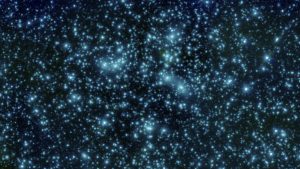Galaxies are herded together by gravity into clusters that can contain anything from 20 up to several thousands of galaxies. These galaxy clusters vary vary in size from three million to 30 million light years across. The smaller clusters contain young gas-rich irregular galaxies and spiral galaxies. The larger, highly evolved galaxy clusters contain giant ellipticals with a cloud of gas at the centre so hot that they emit x-rays. Large galaxy clusters often contain vast clouds of sparse hot gas, detected at x-ray wavelengths.
Giant ellipticals always lie at the centre of large galaxy clusters. The cluster of galaxies that contains our own galaxy is called the Local Group. Lying 52 million light years away is the Virgo Cluster, which is a large irregular cluster of several hundred galaxies.

The shape of galaxy clusters is either spherical or irregular, which is self-explanatory.
Cluster evolution
Galaxy clusters start as loose collections of gas-rich spirals, irregulars and small ellipticals. Under the combined forces of gravity the spirals tend to merge then regenerate back as spirals or as ellipticals, each time driving off gas into the interstellar medium. This forms an irregular cluster that rotates in chaotic fashion until gravitational forces bring about a more ordered clustering, which ends up as a more stable spherical arrangement. Eventually the mass settles into a spherical cluster of elliptical galaxies.
Irregular clusters
The Local Group is the nearest example of an irregular cluster. Members of this group include the major players, the Milky Way, the Andromeda Galaxy, and Triangulum. Barnard’s galaxy (NGC 6822) is a small irregular member. Formax Dwarf Galaxy is a spherical member.
Other irregular clusters include the Sculptor Group, the Hercules Cluster, Abell 2125, and the Virgo Cluster.
Regular clusters
The Fornax Cluster is at a later stage of evolution than the younger Virgo Group. The Fornax regular cluster comprises mainly ellipticals in an even distribution. Other regulars include Hydra Cluster, Abell 2065 and Abell 1689. This last is one of the densest galaxy clusters known with thousands of galaxies packed into a volume barely two million light years across. Abell 2065 is also known as the Corona Borealis Cluster. It contains 400 or more large galaxies.
Galaxy superclusters
Superclusters are chains of a dozen or so galaxy clusters that are linked by gravity. We are part of a supercluster! Called the Local Supercluster it contains us in the Local Group linked to the Virgo Cluster. The entire supercluster stretches over 200 million light years, merging with others at its edge. Within each supercluster the individual galaxy clusters are evolving and contracting. The combined gravitational force of a supercluster is enough to counterbalance the expanding universe. In the case of the Local Supercluster astronomers believe this combined force is pulling clusters together at something like 5.4 million kilometres an hour. In turn the Local Supercluster—also referred to as the Virgo Supercluster—is being sucked towards a mysterious concentration of mass called “The Great Attractor” at a speed of 2.2 million kilometres an hour.
Filaments and voids
Chains of loosely bound galaxies form superclusters, which can be as much as 200 light years in length. These are part of a far more broader structure astronomers describe as “sheets and filaments”, separated by voids of maybe 100 million light years across. These filaments and voids permeate the entire observable universe.
The largest known void is in the Constellation Boötes, not surprisingly called the Boötes Void. It was discovered in 1981 by American astronomer Robert Kirshner (1949 – ) and is estimated to be 330 million light years across. Even so there are a few galaxies that have been found in this “void”. But astronomers point out that since normally there would be 2 000 galaxies in such a vast space, the fact there are less than a 100 means it amounts to being pretty well empty!
Lyman-alpha blobs
Lyman-alpha blobs (LABs) are colossal bubbles. Some are the largest known objects in the universe. One, 200 million light years across, which lies in the Constellation of Aquarius, is 3 000 times the size of the Milky Way. These bubbles are precursors of galaxy clusters. LABs are gigantic clouds of hydrogen gas that emit Lyman-alpha lines. The name reflects the nature of the ultraviolet light they emit, known as Lyman-alpha radiation. It arises from an electron in a hydrogen atom transitioning from the second lowest to the lowest energy level, releasing a photon in the process.
LABs are characterised by the fact that their emission line of ionised hydrogen from these blobs is very strong, and yet all other emissions, including at radio wavelengths, is quite faint. This is unusual. If there was a very luminous source powering the emission, like a supermassive black hole, for example, it might be expected to show emissions in other portions of the spectrum. But it doesn’t.
Why LABs behave this way is an activity that remains to be explained. One theory is that the emissions are from the photo ionisation of gas by an Active Galactic Nucleus. Or perhaps LABs are a cluster of smaller ionised HII regions, like those found in the more common galaxy, but at a very much larger scale, a supermassive galaxy.
By Nigel Benetton, science fiction author of Red Moon Burning and The Wild Sands of Rotar.
Last updated:Monday, 22 March 2021